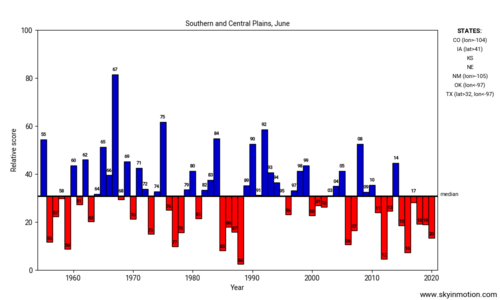Almost every attribute I prefer in a chase day has its likelihood maximized in June: long days, high CAPE, slow storm motions, and a geographical preference for areas NW of the trees and cities like DFW/OKC/TUL. In theory, it's always been June all the way for me. June is also my favorite month overall, even aside from chasing.
With my current job, from 2018-present, I've had limitations in May but have been free to chase almost anything in June. Going in, I thought this would work out well: I'd undoubtedly get screwed when there were banner days >3-4 hours from OKC on weekdays in May, but the ability to chase aggressively in June would compensate. The key assumption was that the period from late May to mid-late June maximizes the prevalence of mesoscale opportunities for tornadic supercells on a day-to-day basis; if you're willing to roam, you should be able to find opportunities most days. And if you take most of the opportunities, a couple are bound to work out well.
That was a great theory, anyway. Each of the past three Junes has been nearly dead, in terms of forecastable setups in the heart of the Plains. I haven't seen a single good June tornado since 2015, back when I was freer to chase, yet less apt to spend money for borderline setups >6 hours from home (being based in OK, that "money-bottlenecked" style of chasing generally meant I leaned more into May and less into June than I do now). June has been chock full of exhaustion and disappointment for me lately.
I'm attaching a plot from my "objective" chase scoring script that really highlights the downfall of June over the past decade, particularly when focusing south of the Dakotas and WY/MT (where, admittedly, some great but very difficult-to-forecast storms have been sprinkled in almost yearly). Every single year of the past ten, save 2014, has come out in the red. There is no other comparably bad period of this duration in the dataset, which goes back to 1955.

The upshot is that June appears to have turned frigid on us, to indulge Jeff's oh-so-eloquent analogy. Now, the critical question is whether that's driven more by standard decadal variability vs. more permanent climate trends, e.g. from AGW. An expansion of the summer doldrums further back into June, on average, would be consistent with some of the research on AGW impacts. But looking at the past 10 years individually, I don't know that it's fair to say the failure mode has always been consistent with that. There are cases like last year where the jet remained active over the heart of chase alley, but moisture and other issues were pervasive. If anything, the perpetual tendency for eastern North America troughing and/or southwest U.S. ridging that has plagued March-April also appears in recent June composites.
I can keep hoping we've simply rolled a lot of consecutive snake eyes by random chance, and that any year now we'll snap back to more expected samples from the same background June climatology we observed for decades prior to 2011. But I'm not sure. My answer in 2010 would've been resoundingly in favor of June, but now I wonder if I'm resigned to failure 80-90% of years without finding a way to shift my most aggressive chasing weeks earlier.

